Citizens’ Eyes on Mnemiopsis: How to Multiply Sightings with a Click!
Abstract
1. Introduction
2. Materials and Methods
3. Results and Discussion
3.1. avvistAPP: Citizens Partecipation
3.2. Mnemiopsis leidyi
3.3. Other Gelatinous Taxa
3.4. Dolphins and Turtles
3.5. Noble Pen Shell Pinna nobilis
4. Conclusions
Author Contributions
Funding
Institutional Review Board Statement
Informed Consent Statement
Data Availability Statement
Acknowledgments
Conflicts of Interest
References
- Lowe, S.; Browne, M.; Boudjelas, S.; De Poorter, M. 100 of the World’s Worst Invasive Alien Species A selection from the Global Invasive Species Database; Invasive Species Specialist Group (ISSG), International Union for Conservation of Nature (IUCN): Auckland, New Zealand, 2000. [Google Scholar]
- Costello, J.H.; Bayha, K.M.; Mianzan, H.W.; Shiganova, T.A.; Purcell, J.E. Transition of Mnemiopsis leidyi (Ctenophora: Lobata) from a native to an exotic species: A review. Hydrobiologia 2012, 690, 21–46. [Google Scholar] [CrossRef]
- Jaspers, C.; Møller, L.F.; Kiørboe, T. Reproduction rate under variable food conditions and starvation in Mnemiopsis leidyi: Significance for the success of a ctenophore. J. Plankton Res. 2015, 37, 1011–1018. [Google Scholar] [CrossRef]
- Malej, A.; Tirelli, V.; Lučić, D.; Paliaga, P.; Vodopivec, M.; Goruppi, A.; Ancona, S.; Benzi, M.; Bettoso, N.; Camatti, E.; et al. Mnemiopsis leidyi in the northern Adriatic: Here to stay? J. Sea Res. 2017, 124, 10–16. [Google Scholar] [CrossRef]
- Purcell, J.E.; Decker, M.B. Effects of climate on relative predation by scyphomedusae and ctenophores on copepods in Chesapeake Bay during 1987-2000. Limnol. Oceanogr. 2005, 50, 376–387. [Google Scholar] [CrossRef]
- Condon, R.H.; Steinberg, D.K. Development, biological regulation, and fate of ctenophore blooms in the York River estuary, Chesapeake Bay. Mar. Ecol. Prog. Ser. 2008, 369, 153–168. [Google Scholar] [CrossRef]
- Tiselius, P.; Moller, L.F. Community cascades in a marine pelagic food web controlled by the non-visual apex predator Mnemiopsis leidyi. J. Plankton Res. 2017, 39, 271–279. [Google Scholar] [CrossRef]
- Travis, J. Invader threatens Black, Azov Seas. Science 1993, 262, 1366–1367. [Google Scholar] [CrossRef]
- Purcell, J.E.; Shiganova, T.A.; Decker, M.B.; Houde, E.D. The ctenophore Mnemiopsis in native and exotic habitats: U.S. estuaries versus the Black Sea basin. Hydrobiologia 2001, 451, 145–176. [Google Scholar] [CrossRef]
- Gallardo, B.; Clavero, M.; Sánchez, M.I.; Vilà, M. Global ecological impacts of invasive species in aquatic ecosystems. Glob. Change Biol. 2016, 22, 151–163. [Google Scholar] [CrossRef]
- Shiganova, T.A.; Sommer, U.; Javidpour, J.; Molinero, J.C.; Malej, A.; Kazmin, A.S.; Isinibilir, M.; Christou, E.; Siokou- Frangou, I.; Marambio, M.; et al. Patterns of invasive ctenophore Mnemiopsis leidyi distribution and variability in different recipient environments of the Eurasian seas: A review. Mar. Environ. Res. 2019, 152, 104791. [Google Scholar] [CrossRef]
- Shiganova, T.A.; Malej, A. Native and non-native ctenophores in the Gulf of Trieste, Northern Adriatic Sea. J. Plankton Res. 2009, 31, 61–71. [Google Scholar] [CrossRef]
- European Marine Board. Marine Citizen Science: Towards an Engaged and Ocean Literate Society; EMB Policy Brief No. 5; European Marine Board IVZW: Ostend, Belgium, 2017; ISSN: 0778-3590; ISBN 978-94-92043-48-1. [Google Scholar]
- Garcia-Soto, C.; Seys, J.J.C.; Zielinski, O.; Busch, J.A.; Luna, S.I.; Baez, J.C.; Domegan, C.; Dubsky, K.; Kotynska-Zielinska, I.; Loubat, P.; et al. Marine Citizen Science: Current state in Europe and new technological developments. Front. Mar. Sci. 2021, 8, 621472. [Google Scholar] [CrossRef]
- Jensen, D.; Campbell, J.; Bakker, K.; Reimer, C. A digital Ecosystem for the planet. UN Environment Programme & UBC 2019. Available online: https://karenbakkerdotorg.files.wordpress.com/2020/01/unep-ubc_digitalecosystemfortheplanet.pdf (accessed on 29 April 2021).
- Boero, F.; Brotz, L.; Gibbons, M.; Piraino, S.; Zampardi, S. Impacts and effects of ocean warming on jellyfish. In Explaining Ocean Warming: Causes, Scale, Effects, and Consequences; Laffoley, D., Baxter, J.M., Eds.; IUCN: Gland, Switzerland, 2016; pp. 213–237. [Google Scholar]
- Zampardi, S.; Licandro, P.; Piraino, S.; Boero, F. Indigenous and non indigenous species along the Italian coasts: Jellyfish records from a “Citizen Science” approach. In Proceedings of the GeoSub 2016 Conference, Ustica, Italy, 13-17 September 2016. [Google Scholar]
- Marambio, M.; Canepa, A.; Lopez, L.; Gauci, A.A.; Gueroun, S.K.M.; Zampardi, S.; Boero, F.; Yahia, O.K.-D.; Yahia, M.N.D.; Fuentes, V.; et al. Unfolding jellyfish bloom dynamics along the Mediterranean basin by transnational citizen science initiatives. Preprints 2021. [Google Scholar] [CrossRef]
- Bellido, J.J.; Baáez, J.C.; Souviron-Priego, L.; Ferri Yánez, F.; Salas, C.; López, J.; Real, R. Atmospheric indices allow anticipating the incidence of jellyfish coastal swarms. Mediterr. Mar. Sci. 2020, 21, 289–297. [Google Scholar] [CrossRef]
- Garcia-Soto, C.; van der Meeren, G.I.; Busch, J.A.; Delany, J.; Domegan, C.; Dubsky, K.; Fauville, G.; Gorsky, G.; von Juterzenka, K.; Malfatti, F.; et al. Advancing citizen science for coastal and ocean research. In European Marine Board Position Paper 23; French, V., Kellett, P., Delany, J., McDonough, N., Eds.; European Marine Board: Ostend, Belgium, 2017; p. 112. ISBN 978-94-92043-30-6. [Google Scholar]
- Crall, A.W.; Newman, G.J.; Stohlgren, T.J.; Holfelder, K.A.; Graham, J.; Waller, D.M. Assessing citizen science data quality: An invasive species case study. Conserv. lett. 2011, 4, 433–442. [Google Scholar] [CrossRef]
- Boero, F.; Putti, M.; Trainito, E.; Prontera, E.; Piraino, S.; Shiganova, T.A. First records of Mnemiopsis leidyi (Ctenophora) from the Ligurian, Thyrrhenian and Ionian Seas (Western Mediterranean) and first record of Phyllorhiza punctata (Cnidaria) from the Western Mediterranean. Aquat. Invasions 2009, 4, 675–680. [Google Scholar] [CrossRef]
- Fiori, E.; Benzi, M.; Ferrari, C.R.; Mazziotti, C. Zooplankton community structure before and after Mnemiopsis leidyi arrival. J. Plankton Res. 2019, 41, 803–820. [Google Scholar] [CrossRef]
- Pestorić, B.; Lučić, D.; Bojanić, N.; Vodopivec, M.; Kogovšek, T.; Violić, I.; Paliaga, P.; Malej, A. Scyphomedusae and Ctenophora of the Estern Adriatic sea: Historical overview and new data. Diversity 2021, 13, 186. [Google Scholar] [CrossRef]
- Pierson, J.; Camatti, E.; Hood, R.; Kogovšek, T.; Lučić, D.; Tirelli, V.; Malej, A. Mesozooplankton and gelatinous zooplankton in the face of environmental stressors. In Coastal Ecosystems in Transition: A Comparative Analysis of the Northern Adriatic and Chesapeake Bay; Malone, T., Malej, A., Faganeli, J., Eds.; American Geophysical Union: Washington, DC, USA, 2021. [Google Scholar] [CrossRef]
- Dragičević, B.; Anadoli, O.; Angel, D.; Benabdi, M.; Bitar, G.; Castriota, L.; Crocetta, F.; Deidun, A.; Dulčić, D.; Edelist, D.; et al. New Mediterranean Biodiversity Records (December 2019). Mediterr. Mar. Sci. 2019, 20, 647. [Google Scholar] [CrossRef]
- Marchessaux, G.; Faure, V.; Chevalier, C.; Thibault, D. Refugia area for the ctenophore Mnemiopsis leidyi A. Agassiz 1865 in the Berre Lagoon (southeast France): The key to its persistence. Reg. Stud. Mar. Sci. 2020, 39, 101409. [Google Scholar] [CrossRef]
- Casale, P.; Affronte, M.; Scaravelli, D.; Lazar, B.; Vallini, C.; Luschi, P. Foraging grounds, movement patterns and habitat connectivity of juvenile loggerhead turtles (Caretta caretta) tracked from the Adriatic Sea. Mar. Biol. 2012, 159, 1527–1535. [Google Scholar] [CrossRef]
- Genov, T.; Kotnjek, J.; Lesjak, A.; Hace, A.; Fortuna, C.M. Bottlenose dolphins (Tursiops truncatus) in Slovenian and adjacent waters (northern Adriatic Sea). Ann. Ser. Hist. Nat. 2008, 18, 227–244. [Google Scholar]
- Genov, T.; Centrih, T.; Kotnjek, P.; Hace, A. Behavioural and temporal partitioning of dolphin social groups in the northern Adriatic Sea. Mar. Biol. 2019, 166, 11. [Google Scholar] [CrossRef] [PubMed]
- Gaspari, S.; Scheinin, A.; Holcer, D.; Fortuna, C.; Natali, C.; Genov, T.; Frantzis, A.; Chelazzi, G.; Moura, A.E. Drivers of population structure of bottlenose dolphin (Tursiops truncatus) in the Eastern Mediterranean Sea. Evol. Biol. 2015, 42, 177–190. [Google Scholar] [CrossRef]
- Šarić, T.; Župan, I.; Aceto, S.; Villari, G.; Palić, D.; De Vico, G.; Carella, F. Epidemiology of noble pen shell (Pinna nobilis L. 1758) mass mortality events in Adriatic Sea is characterised with rapid spreading and acute disease progression. Pathogens 2020, 9, 776. [Google Scholar] [CrossRef]
- IUCN. The Noble pen Shell (Pinna nobilis) Now Critically Endangered. Available online: https://www.iucn.org/sites/dev/files/content/documents/pinna_nobilis_iucn_final.pdf (accessed on 23 April 2021).
- Santori, C.; Keith, R.J.; Whittington, C.M.; Thompson, M.B.; Van Dyke, J.U.; Spencer, R.-J. Changes in participant behaviour and attitudes are associated with knowledge and skills gained by using a turtle conservation citizen science app. People Nat. 2021, 3, 66–76. [Google Scholar] [CrossRef]
- Freiwald, J.; Meyer, R.; Caselle, J.E.; Blanchette, C.A.; Hovel, K.; Neilson, D.; Dugan, J.; Altstatt, J.; Nielsen, K.; Bursek, J. Citizen science monitoring of marine protected areas: Case studies and recommendations for integration into monitoring programs. Mar. Ecol. 2018, 39, e12470. [Google Scholar] [CrossRef]
- Dickinson, J.L.; Zuckerberg, B.; Bonter, D.N. Citizen Science as an Ecological Research Tool: Challenges and Benefits. Annu. Rev. Ecol. Evol. Syst. 2010, 41, 149–172. [Google Scholar] [CrossRef]
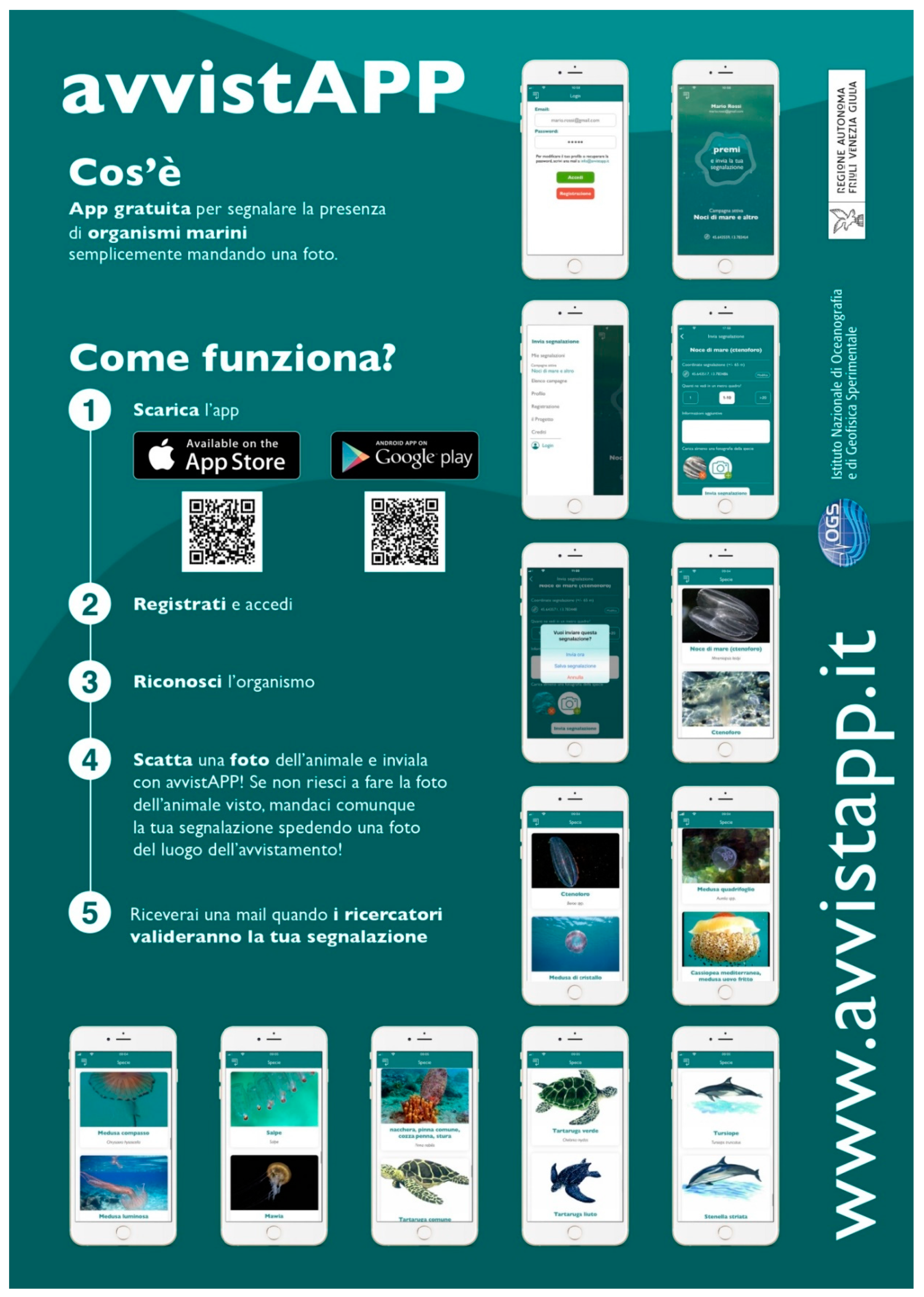
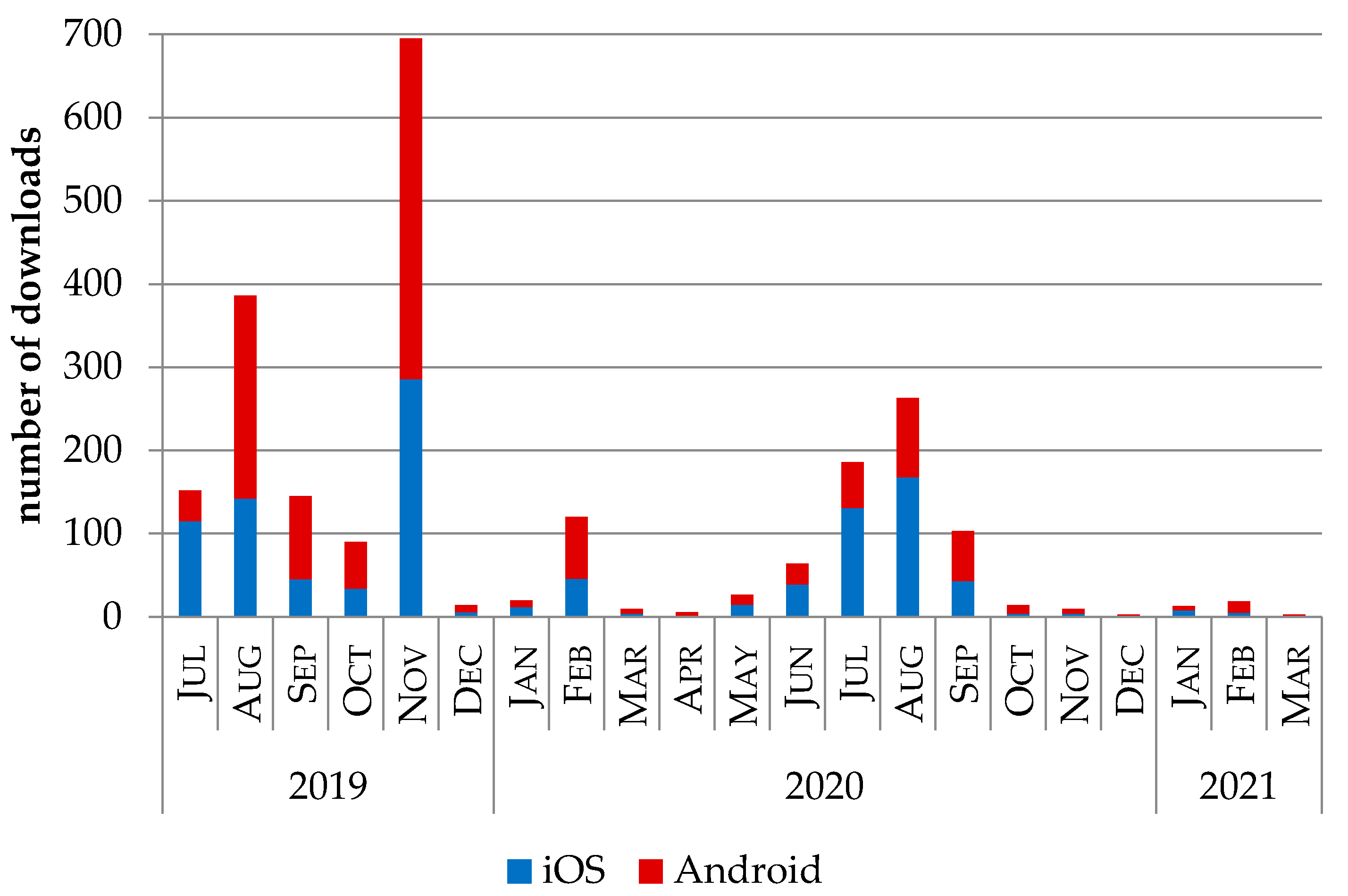
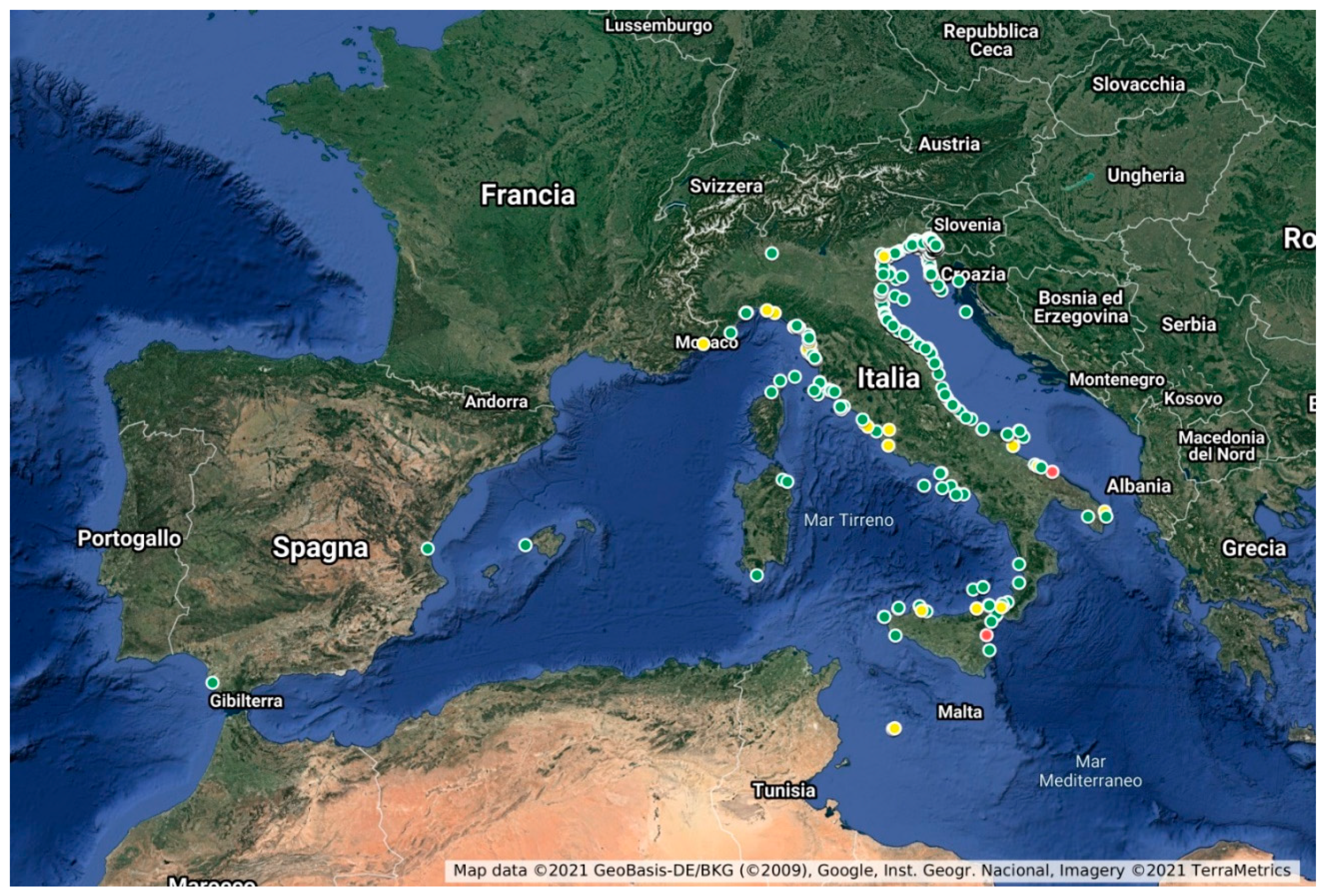
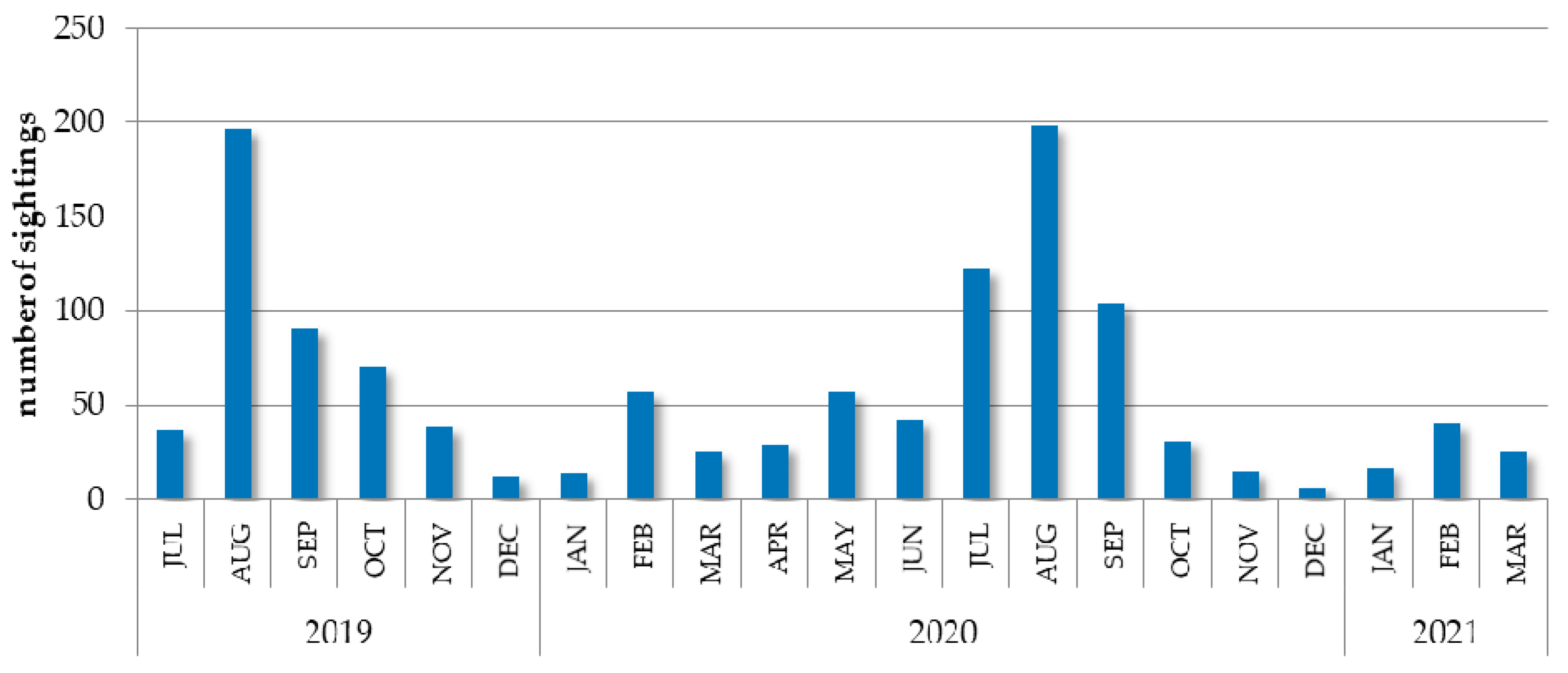
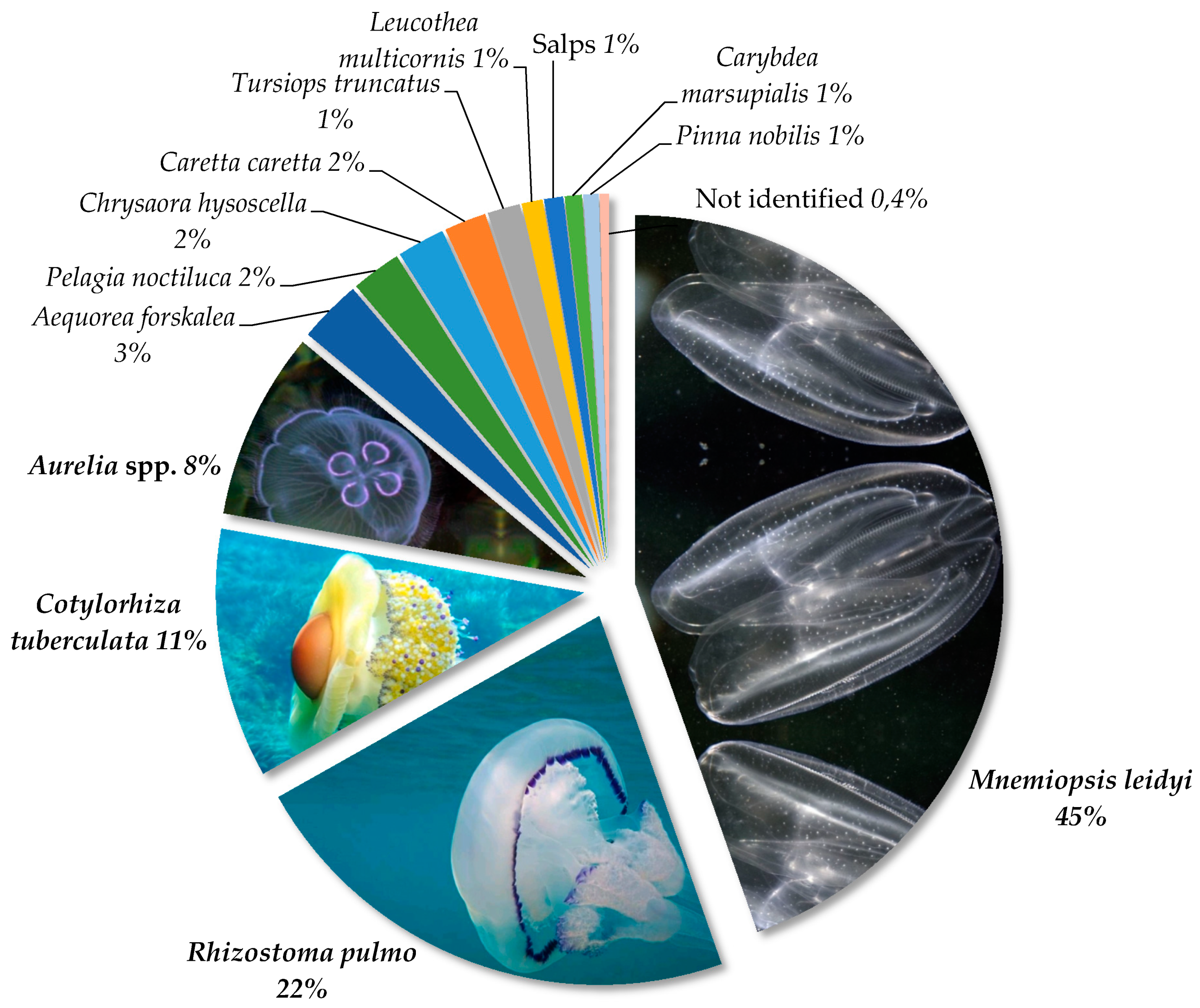
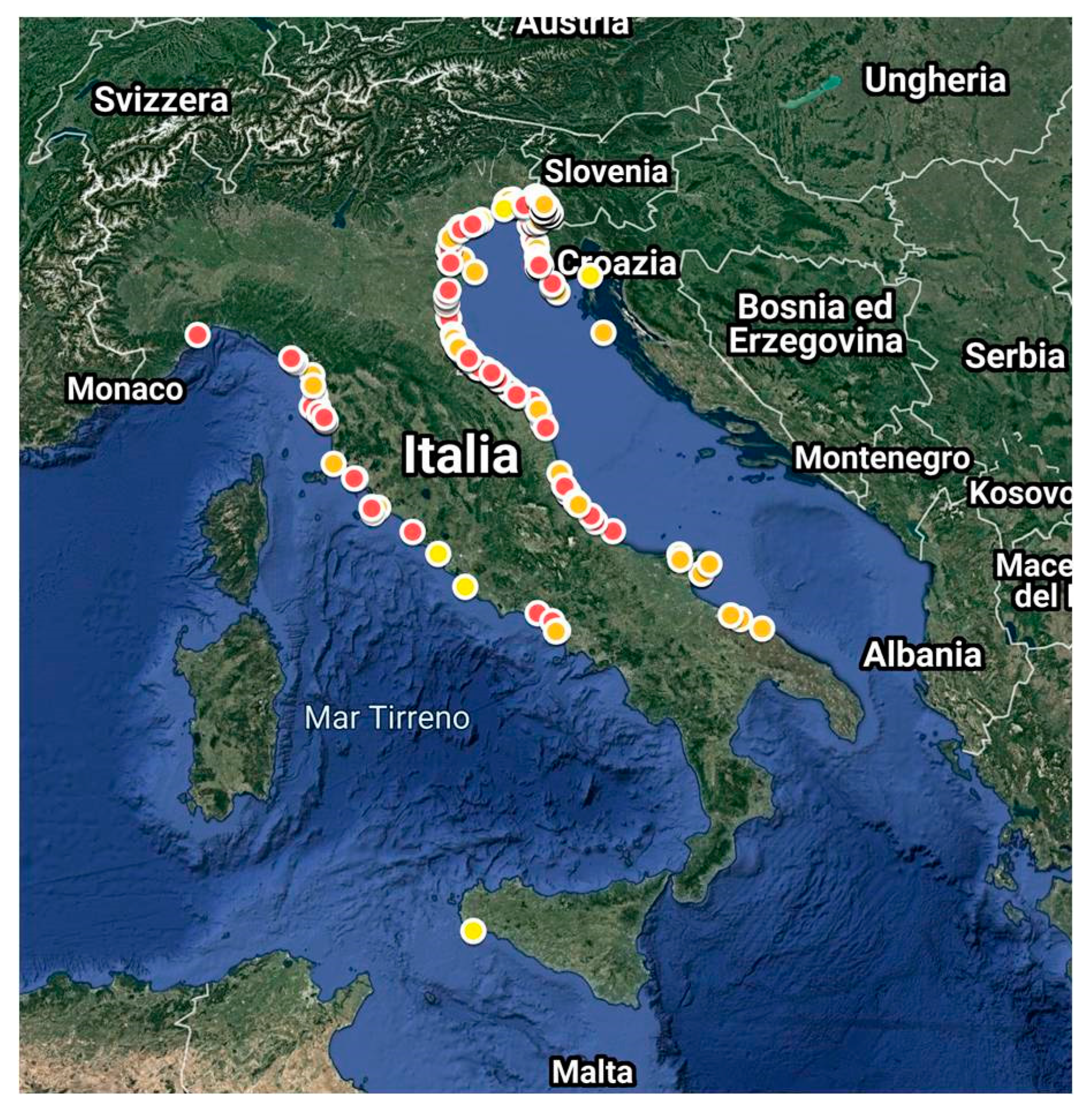
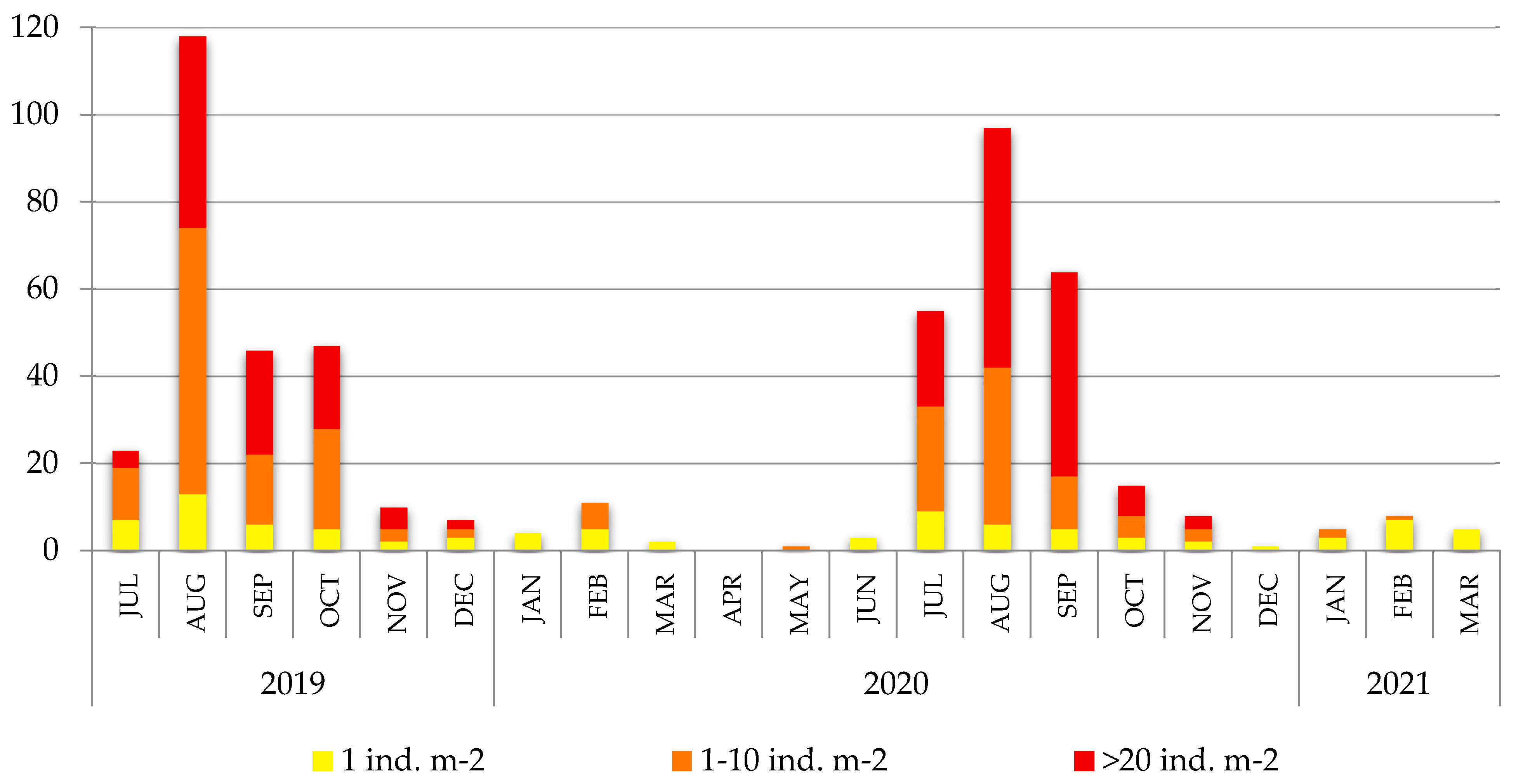

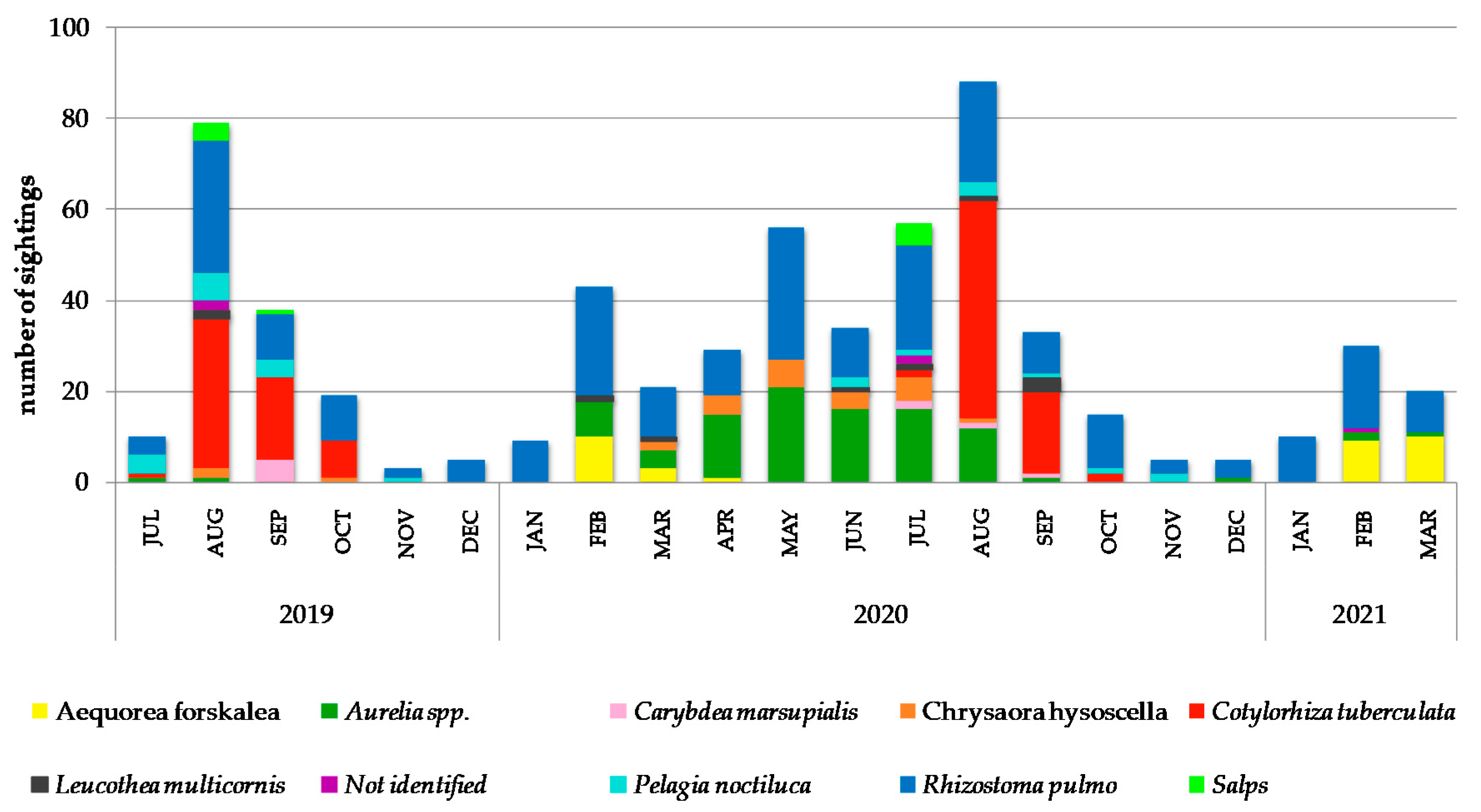
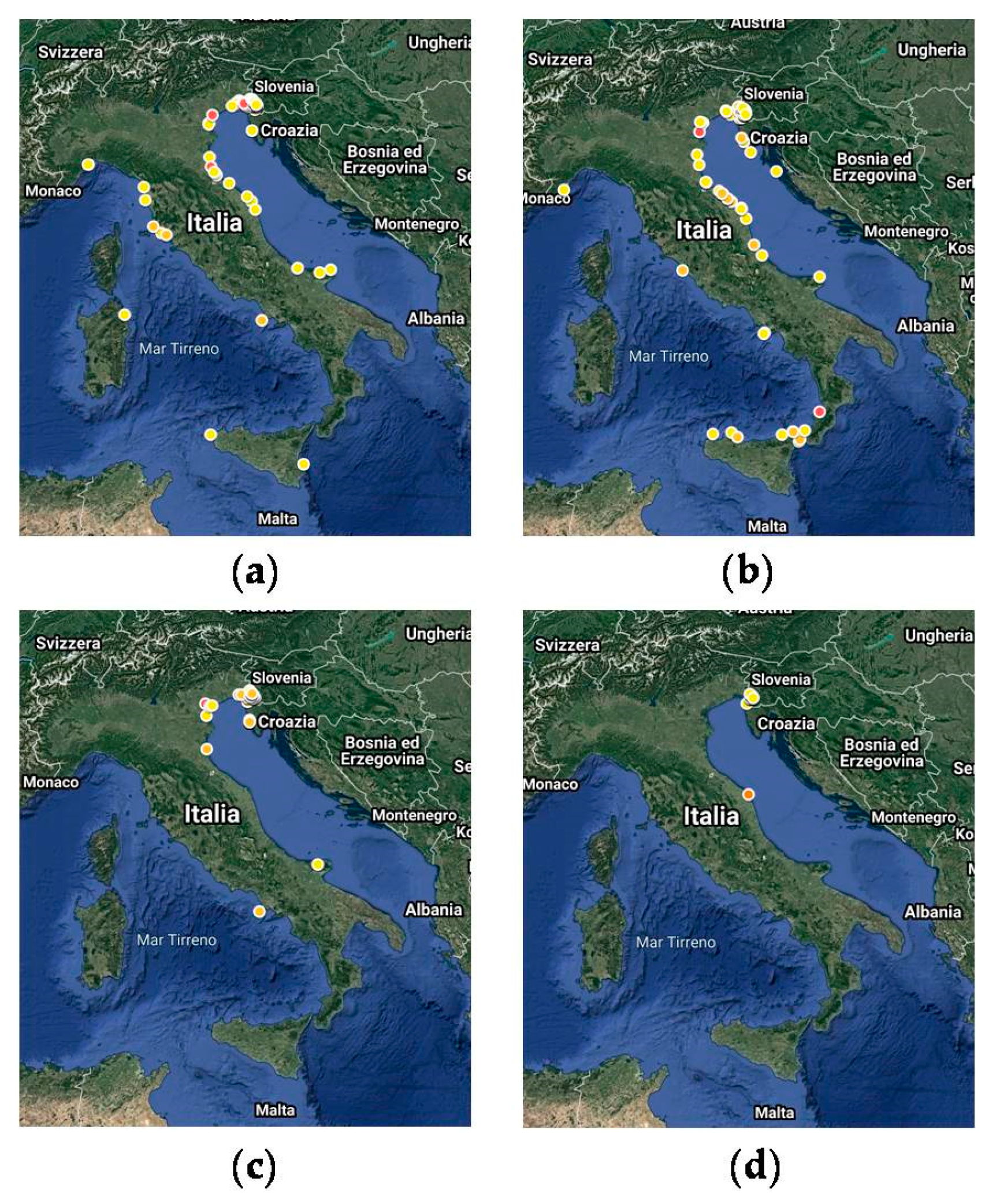
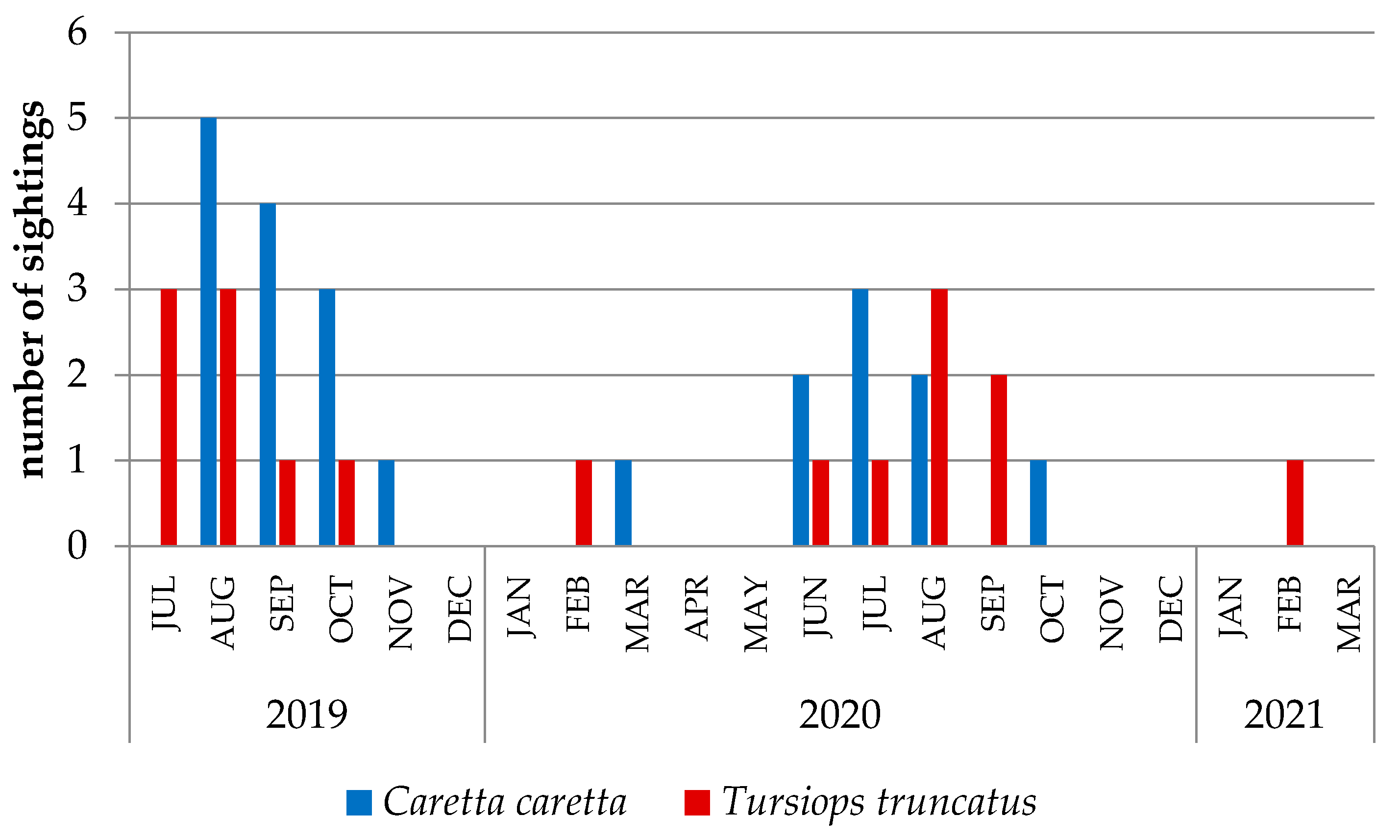
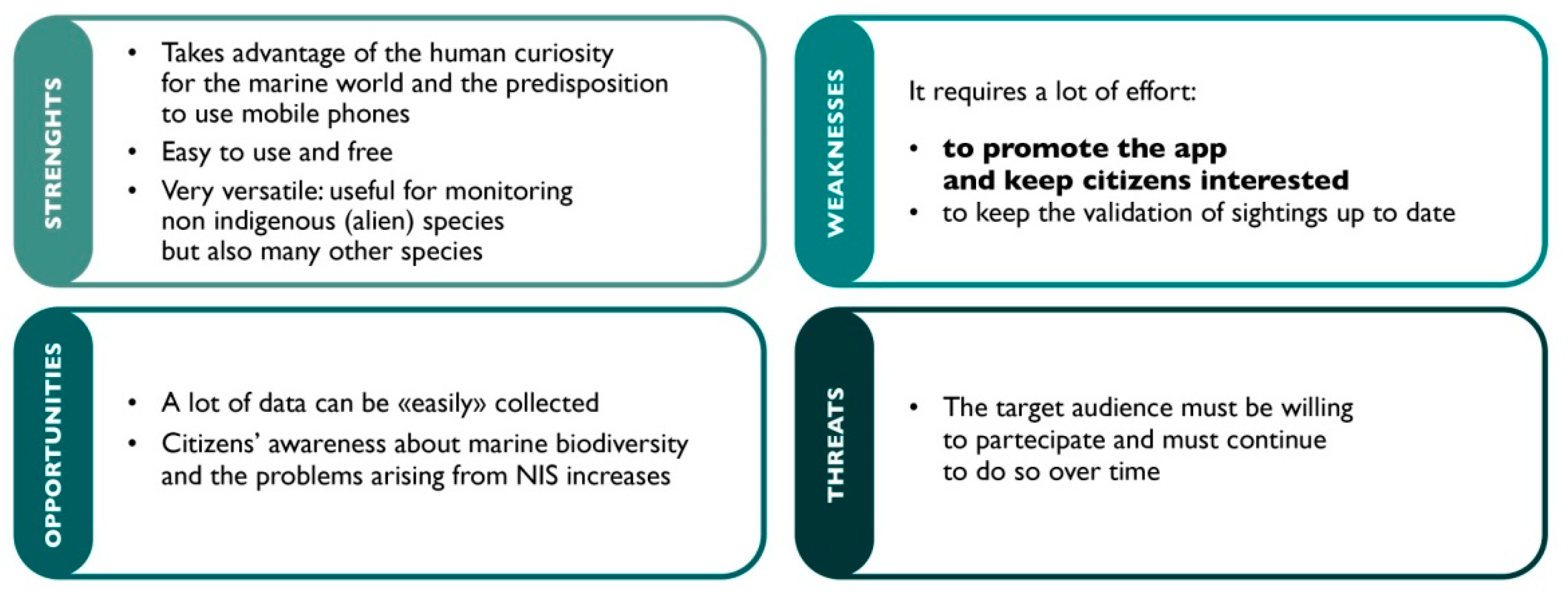
| Taxon | Abundance Range | ||
|---|---|---|---|
| Mnemiopsis leidyi A. Agassiz, 1865 | 1 ind. m−2 | 1–10 ind. m−2 | >20 ind. m−2 |
| Leucothea multicornis (Quoy and Gaimard, 1824) | |||
| Beroe spp. Muller, 1776 | |||
| Aequorea forskalea Péron and Lesueur, 1810 | |||
| Aurelia spp. Lamarck, 1816 | |||
| Cotylorhiza tuberculata (Macri, 1778) | |||
| Rhizostoma pulmo (Macri, 1778) | |||
| Carybdea marsupialis (Linnaeus, 1758) | |||
| Chrysaora hysoscella (Linnaeus, 1767) | |||
| Pelagia noctiluca (Forsskål, 1775) | |||
| Salps | |||
| Mawia benovici (Piraino, Aglieri, Scorrano and Boero, 2014) | |||
| Pinna nobilis Linnaeus, 1758 | 1–3 ind. m−2 | 4–10 ind. m−2 | >10 ind. m−2 |
| Caretta caretta (Linnaeus, 1758) | 1–3 ind. | 4–10 ind. | >10 ind. |
| Chelonia mydas (Linnaeus, 1758) | |||
| Dermochelys coriacea (Vandelli, 1761) | |||
| Tursiops truncatus (Montagu, 1821) | 1–5 ind. | 6–20 ind. | >20 ind. |
| Stenella coeruleoalba (Meyen, 1833) | |||
| Delphinus delphis Linnaeus, 1758 | |||
| Not identified | 1–3 ind. | 4–10 ind. | >10 ind. |
| Jellyfish | 2019 | 2020 | 2021 | ||||||
|---|---|---|---|---|---|---|---|---|---|
| 1 ind. m−2 | 1–10 ind. m−2 | >20 ind. m−2 | 1 ind.m−2 | 1–10 ind.m−2 | >20 ind.m−2 | 1 ind.m−2 | 1–10 ind. m−2 | >20 ind. m−2 | |
| Mnemiopsis leidyi | 36 | 117 | 98 | 40 | 8 | 134 | 15 | 3 | |
| Leucothea multicornis | 3 | 5 | 3 | ||||||
| Aequorea forskalea | 10 | 4 | 12 | 7 | |||||
| Aurelia spp. | 1 | 1 | 52 | 35 | 6 | 1 | 1 | 1 | |
| Cotylorhiza tuberculata | 52 | 8 | 40 | 26 | 4 | ||||
| Rhizostoma pulmo | 49 | 11 | 119 | 37 | 11 | 29 | 5 | 3 | |
| Carybdea marsupialis | 4 | 1 | 4 | ||||||
| Chrysaora hysoscella | 3 | 22 | |||||||
| Pelagia noctiluca | 8 | 6 | 2 | 4 | 5 | 1 | |||
| Salps | 4 | 1 | 3 | 2 | |||||
| Molluscs | 1–3 ind. m−2 | 4–10 ind.m−2 | >10 ind.m−2 | 1–3 ind.m−2 | 4–10 ind.m−2 | >10 ind.m−2 | 1–3 ind.m−2 | 4–10 ind.m−2 | >10 ind.m−2 |
| Pinna nobilis | 5 | 2 | 1 | ||||||
| Turtles | 1–3 ind. | 4–10 ind. | >10 ind. | 1–3 ind. | 4–10 ind. | >10 ind. | 1–3 ind. | 4–10 ind. | >10 ind. |
| Caretta caretta | 13 | 8 | 1 | ||||||
| Dolphins | 1–5 ind. | 6–20 ind. | >20 ind. | 1–5 ind. | 6–20 ind. | >20 ind. | 1–5 ind. | 6–20 ind. | >20 ind. |
| Tursiops truncatus | 6 | 2 | 8 | 1 | |||||
Publisher’s Note: MDPI stays neutral with regard to jurisdictional claims in published maps and institutional affiliations. |
© 2021 by the authors. Licensee MDPI, Basel, Switzerland. This article is an open access article distributed under the terms and conditions of the Creative Commons Attribution (CC BY) license (https://creativecommons.org/licenses/by/4.0/).
Share and Cite
Tirelli, V.; Goruppi, A.; Riccamboni, R.; Tempesta, M. Citizens’ Eyes on Mnemiopsis: How to Multiply Sightings with a Click! Diversity 2021, 13, 224. https://doi.org/10.3390/d13060224
Tirelli V, Goruppi A, Riccamboni R, Tempesta M. Citizens’ Eyes on Mnemiopsis: How to Multiply Sightings with a Click! Diversity. 2021; 13(6):224. https://doi.org/10.3390/d13060224
Chicago/Turabian StyleTirelli, Valentina, Alenka Goruppi, Rodolfo Riccamboni, and Milena Tempesta. 2021. "Citizens’ Eyes on Mnemiopsis: How to Multiply Sightings with a Click!" Diversity 13, no. 6: 224. https://doi.org/10.3390/d13060224
APA StyleTirelli, V., Goruppi, A., Riccamboni, R., & Tempesta, M. (2021). Citizens’ Eyes on Mnemiopsis: How to Multiply Sightings with a Click! Diversity, 13(6), 224. https://doi.org/10.3390/d13060224






